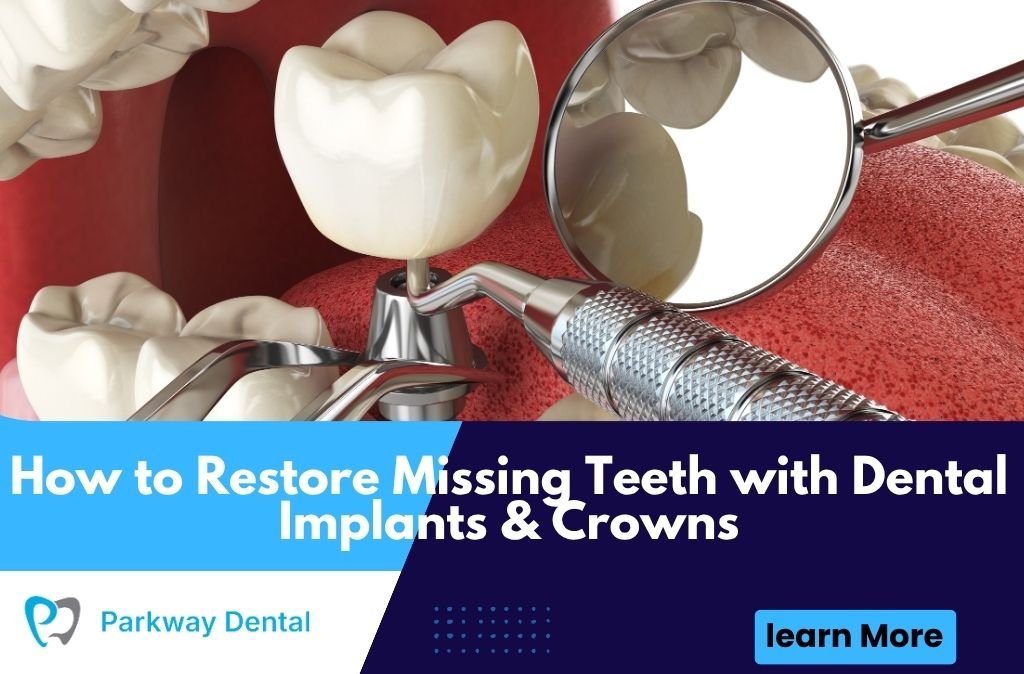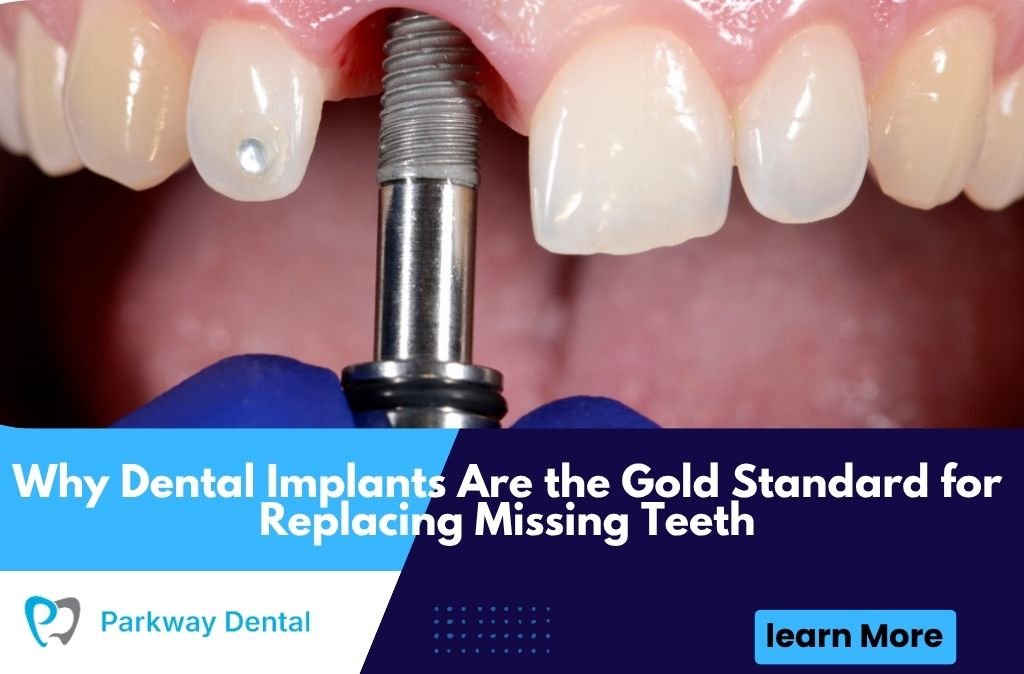Dental implants and crowns are the most reliable way to restore missing teeth and bring back natural function and appearance. This article explains how implants replace tooth roots and support crowns that look and feel real. It covers every stage of treatment, from consultation and surgery to recovery and maintenance. It also discusses benefits like improved confidence, durability, and comfort compared to bridges or dentures. With modern technology and expert care, implants and crowns can last for decades, preserving oral health, preventing bone loss, and helping patients enjoy a strong, beautiful, and confident smile for life.
Understanding the Impact of Missing Teeth
Missing teeth can affect much more than your smile. They influence how you eat, speak, and even how your face looks. When a tooth is lost, the surrounding teeth may shift, creating gaps and misalignment. Over time, the jawbone under the missing tooth starts to shrink, leading to premature aging and a sunken facial appearance. Replacing missing teeth restores not only your oral health but also your confidence and comfort.
The Emotional and Functional Effects of Tooth Loss
Tooth loss can make people self-conscious, hesitant to smile, and even avoid social situations. It also makes chewing difficult and can lead to uneven wear on remaining teeth. Restoring your smile can bring back both comfort and confidence.
Why Replacing Missing Teeth Matters
Replacing missing teeth helps maintain jaw strength and prevent neighboring teeth from shifting. Early restoration saves you from more complex procedures later and keeps your bite stable.
Exploring Modern Solutions for Tooth Restoration
Today’s dentistry offers several solutions for missing teeth, ranging from bridges to dental implants. Each method has its benefits depending on your needs, bone structure, and overall health. Among them, dental implants combined with crowns provide the most natural and long-lasting results.
Traditional vs. Modern Restoration Options
Traditional bridges rely on adjacent teeth for support, while implants replace the entire tooth structure independently. Implants preserve jawbone health and feel more like real teeth.
Why Dental Implants Are the Gold Standard
Implants offer durability, stability, and aesthetic perfection. Unlike removable dentures, they integrate with your jawbone, functioning like natural tooth roots and supporting crowns securely.
Understanding Dental Implants
Dental implants are titanium posts surgically placed into the jawbone to replace missing tooth roots. They act as stable anchors for crowns, bridges, or dentures. This innovative solution restores both the function and aesthetics of your teeth, making it one of the most successful treatments in modern dentistry.
How Dental Implants Work
Once inserted, the implant fuses with the jawbone through a process called osseointegration. This creates a strong foundation for the artificial tooth and prevents bone loss.
Types of Dental Implants
Common types include endosteal implants (placed in the jawbone) and subperiosteal implants (placed above it). The choice depends on bone density and individual needs.
The Step-by-Step Process of Getting Dental Implants
Getting dental implants involves several stages, each crucial for long-term success. While the timeline may vary, the results are worth the patience.
Initial Consultation and Assessment
Your dentist evaluates bone density, gum health, and oral hygiene. X-rays or 3D scans help plan implant placement accurately.
Implant Placement Surgery
A titanium post is surgically placed into the jawbone under local anesthesia. The area then heals over several months as the implant integrates with the bone.
Healing and Osseointegration
During this phase, the implant becomes part of your jaw structure. This stability ensures the crown remains secure once attached.
Attaching the Abutment and Crown
Once healed, an abutment is attached to the implant. The custom-made crown is then placed on top, completing your new tooth.
Understanding Dental Crowns
Dental crowns are custom-made caps that fit over implants or damaged teeth. They restore the tooth’s shape, size, and strength while enhancing its appearance. When used with implants, crowns complete the replacement process, making your new tooth look and function like a natural one.
Materials Used in Crowns
Crowns can be made from porcelain, ceramic, zirconia, or metal alloys. Porcelain and zirconia are preferred for their strength and natural look.
Custom Design for Natural Aesthetics
Each crown is carefully designed to match your tooth color, shape, and size. This ensures seamless blending with your natural smile.
The Benefits of Dental Implants and Crowns
Implants and crowns together offer unparalleled comfort, durability, and aesthetics. They’re designed to look, feel, and function like real teeth while supporting long-term oral health.
Long-Term Durability
With proper care, dental implants can last decades—often a lifetime—making them a wise investment.
Natural Appearance and Feel
Crowns mimic the color, texture, and translucence of natural teeth, giving you a confident smile without anyone noticing the difference.
Restored Function and Comfort
Implants restore your ability to chew, speak, and smile naturally. They eliminate the discomfort and inconvenience of removable dentures.
The Role of Technology in Implant Dentistry
Modern technology has transformed implant procedures, making them safer, faster, and more predictable. Dentists now use advanced tools for precision and patient comfort.
3D Imaging and Digital Scans
These technologies help plan exact implant placement, reducing surgical risks and improving accuracy.
Computer-Guided Surgery
Computer-guided implant placement ensures perfect positioning, resulting in better healing and long-term success.
Advanced Materials
Modern titanium alloys and ceramic implants enhance strength, biocompatibility, and aesthetics.
Bone Health and Jaw Support
Implants don’t just replace teeth—they preserve your jawbone. When a tooth is lost, the bone beneath begins to weaken. Implants stimulate the bone, preventing deterioration.
Preventing Bone Loss
The implant acts like a natural tooth root, transmitting chewing pressure to the bone, which keeps it strong and dense.
Maintaining Facial Structure
By preventing bone shrinkage, implants help maintain your facial shape and youthful appearance.
Comparing Dental Implants to Other Tooth Replacement Options
It’s important to understand how implants differ from bridges or dentures to make an informed decision.
Dental Implants vs. Bridges
Bridges require grinding down healthy teeth for support, while implants stand independently, preserving natural enamel.
Dental Implants vs. Dentures
Dentures can slip and cause irritation, but implants stay fixed in place, offering greater comfort and confidence.
Cost vs. Longevity
Although implants cost more initially, their durability and minimal maintenance make them more cost-effective over time.
The Aesthetic Value of Implants and Crowns
Dental implants and crowns don’t just restore teeth—they enhance your entire smile. A well-designed crown aligns perfectly with your gum line, giving a balanced, natural look.
Matching Color and Shape
Your dentist uses precise shade guides to ensure the crown matches your existing teeth for a seamless finish.
Achieving Natural Proportions
Proportion and symmetry are crucial for aesthetics. A skilled dentist designs crowns that harmonize with your facial features.
Caring for Your Dental Implants and Crowns
Proper care ensures your implants and crowns last for years without complications. Maintenance is similar to caring for natural teeth.
Daily Oral Hygiene
Brush twice daily with a soft-bristle toothbrush and non-abrasive toothpaste. Floss gently around implants to remove plaque.
Routine Dental Check-Ups
Regular visits help your dentist monitor implant health and clean areas you can’t reach at home.
Avoiding Bad Habits
Avoid chewing ice, biting pens, or using teeth to open packages. These habits can damage crowns.
Common Concerns and Misconceptions
Some patients hesitate due to myths surrounding implant surgery or cost. Understanding the facts helps you make an informed choice.
Implant Surgery Is Painful
Modern anesthesia and technology make implant procedures virtually painless, with mild post-surgery discomfort manageable through medication.
Implants Are Too Expensive
While implants cost more upfront, their longevity and benefits often make them more economical than repeated dental work.
They Look Artificial
High-quality crowns designed by skilled cosmetic dentists look and feel identical to real teeth.
The Longevity and Success Rate of Dental Implants
Dental implants have one of the highest success rates in dentistry—over 95%. Their lifespan depends on oral hygiene, lifestyle, and overall health.
Factors That Influence Longevity
Proper cleaning, regular dental checkups, and healthy gums help implants last longer. Smoking and neglect reduce their success rate.
Lifelong Investment
With good care, implants can last a lifetime, making them one of the most reliable restorative treatments available.
Smile Restoration and Confidence
Restoring missing teeth goes beyond function—it rejuvenates your confidence and emotional well-being. Patients often notice positive changes in how they speak, eat, and interact socially after getting implants and crowns.
Reclaiming Your Smile
A complete smile encourages self-assurance and comfort in daily life. Many patients report feeling more outgoing and positive after restoration.
The Psychological Benefits
Replacing missing teeth often relieves anxiety and embarrassment, improving mental well-being and self-image.
Preparing for Your Dental Implant Journey
Preparation ensures smooth treatment and faster recovery.
Dental Evaluation
Your dentist assesses bone health, gum condition, and overall oral hygiene to determine implant suitability.
Customized Treatment Plan
A detailed plan outlines the procedure timeline, expected outcomes, and care instructions.
Pre-Surgery Instructions
You may be advised to quit smoking, adjust medications, or follow a special diet to support healing.
The Recovery Process After Implant Placement
Recovery varies by individual, but following post-surgery care helps you heal faster and more comfortably.
Immediate Aftercare
Use cold compresses to reduce swelling and eat soft foods for a few days after surgery.
Healing Timeline
Most patients experience full healing in three to six months, allowing the implant to integrate securely with the jawbone.
Follow-Up Visits
Regular follow-ups help monitor healing progress and ensure the implant remains stable before placing the final crown.
Combining Implants with Other Restorative Treatments
In some cases, implants are part of a larger restoration plan involving other treatments like bridges or dentures.
Implant-Supported Bridges
For multiple missing teeth, implant-supported bridges provide strong, stable replacements without affecting adjacent teeth.
Implant-Supported Dentures
These dentures snap onto implants for added stability, eliminating the slipping and irritation common with traditional dentures.
Cost and Financing Options
Implant and crown treatments vary in cost based on materials, procedures, and customization.
Average Costs
Single implants typically cost between $3,000–$5,000, depending on complexity and materials used.
Financing Options
Many dental offices offer flexible payment plans, allowing patients to spread costs over time.
Value for Money
Considering their durability and aesthetic benefits, implants often outlast and outperform other replacement methods, offering long-term value.
Future Innovations in Implant Dentistry
Dental implant technology continues to evolve, offering even better outcomes and shorter recovery times.
Immediate Load Implants
Also known as “same-day implants,” this technique allows patients to receive implants and temporary crowns in one visit.
3D-Printed Implants
These offer customized fit and faster production times, enhancing precision and comfort.
Bioengineered Materials
New materials are improving osseointegration and reducing healing time, paving the way for the next generation of implants.
Conclusion
Dental implants and crowns are the most advanced and natural way to restore missing teeth. They bring back function, beauty, and confidence while preserving oral health for the long term. Choosing an experienced dentist and following proper care ensures lasting results that truly transform your smile. Whether you’re replacing one tooth or several, implants provide the perfect blend of strength and aesthetics for a lifetime of smiles.
Dentist in West Roxbury, MA offers expert care to restore missing teeth with precision, comfort, and artistry — helping patients regain their natural smiles and confidence.
FAQs
How long do dental implants last?
With proper care, dental implants can last 20 years or longer, often a lifetime, depending on oral hygiene and lifestyle.
Is implant surgery painful?
No. It’s performed under local anesthesia, and most patients experience only mild discomfort afterward.
How do I know if I’m a good candidate for implants?
Healthy gums, sufficient bone density, and good oral hygiene make you an ideal candidate for implants.
Are dental crowns permanent?
Crowns typically last 10–15 years, but with excellent care, they can last even longer.
Can dental implants fail?
Implant failure is rare but can occur due to poor oral hygiene, smoking, or gum disease. Regular dental visits help prevent this.





